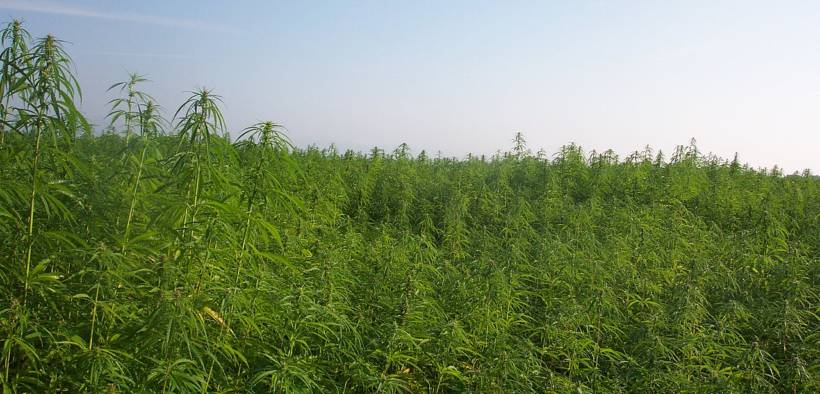Why This Farmer Went From Raising Chickens to Growing Industrial Hemp

There is a way out of our cruel, unjust food system.
Mike Weaver is a trailblazer, boldly speaking out against the very industry that provided his livelihood. In 2016, he exposed the inhumane conditions and unfair labor practices that hold many farmers prisoners inside big animal agriculture farms, and found a way out, transitioning from chicken farming to hemp production. There are many more Mike Weavers in rural America, stuck inside an unjust food system, waiting for a way out.
When I walked into a chicken barn for the first time, I got a taste of what farmers like Mike experienced. I was hit by the stench. As an animal welfare scientist, I was taken aback. The ammonia-laden air made breathing something I tried not to do. It was so dim—dark enough to make seeing difficult yet too bright to permit sleep. Tens of thousands of chickens sat packed together, most of them motionless. As I walked, the mass of chickens parted and made way for my steps but only at the last second, when the birds had to move or risk being trampled.
This is the reality of modern chicken production, which is part of a broken food system that negatively impacts everyone involved.
But what if chicken farmers could be part of the solution to the problem? For a number of reasons, many chicken farmers actually seek to get out of this business and transition to growing plants instead. The organization I work for, Mercy For Animals recently launched the Transfarmation Project to help them do just that: transition from animal farming to plant production. Before I say more, it’s important to first understand why we must fix our food system.
Today’s chicken industry poses serious animal welfare concerns. Conventional chickens, or “broilers” as the industry calls them, suffer a wide range of welfare problems. They are bred to grow so rapidly that their skeletal and cardiovascular systems cannot keep up with their growth, and they’re slaughtered as mere juveniles. The high rates of lameness mean many cannot walk without pain. They often die of metabolic diseases, like ascites and sudden death syndrome, or bacterial diseases like gangrenous dermatitis, never reaching the slaughterhouse.
Our planet suffers too. Greenhouse gas emissions from raising farmed animals make up 14.5 percent of global human-induced emissions. Animal agriculture uses almost one-third of the planet’s ice-free land, while feed production occupies a third of the cropland.
Historically, animal protection groups have vilified farmers for these ills, but a little known secret is that many farmers struggle to survive in today’s farming economy where factory farming dominates. The problem is not black and white. Most farmers grew up in farming communities and are doing what they know while supporting their families. Chicken farmers often go into massive debt and enter into restrictive contracts with large meat producers, like Tyson and Pilgrim’s Pride.
As agriculture has become consolidated among a handful of enormous multinational conglomerates, the debt-to-income ratio of farmers has skyrocketed to the highest level in three decades. Between 2012 and 2018, the Small Business Administration backed over 1,500 loans to poultry growers averaging over $1 million per loan. Twenty percent of contract chicken farmers made less than $19,000 per year in 2011. Nine in 10 farmers polled in 2019 said financial issues, business problems, or fear of losing their farms impacted their mental health. No wonder so many farmers want out.
Animal farmers suffer physically too, with elevated rates of bronchitis and chronic obstructive pulmonary disease. And the physical toll doesn’t end at a farmer’s property line. Because factory farms are such major polluters, farming communities suffer disproportionately from a plethora of health problems, including asthma, eye irritation, nausea, headaches, and even mental illness.
While animal farmers should continue to provide food for Americans and supporting their families, this can be done by adopting more humane practices like growing plants instead. So animal protection groups and plant-based food companies are banding together and working with farmers rather than against them to transform our food system. The Transfarmation Project by Mercy For Animals, the Rancher Advocacy Program by Rowdy Girl Sanctuary, and a farm transition project of Miyoko’s Creamery are all helping animal farmers transition to growing crops used for plant-based products and creating a better future for farmers, and their families, animals and the planet.
While these programs seek to be part of the solution to our broken food system, public support, and legislative changes will accelerate progress. Government subsidies could be redirected from animal agriculture to plant agriculture. While the path forward isn’t clear yet, we do know that we must work together to create a food system that feeds a growing human population while being more compassionate, just and sustainable.
This article was produced by Earth | Food | Life, a project of the Independent Media Institute.















